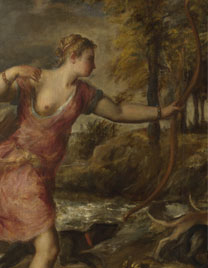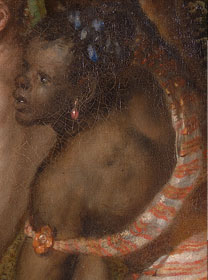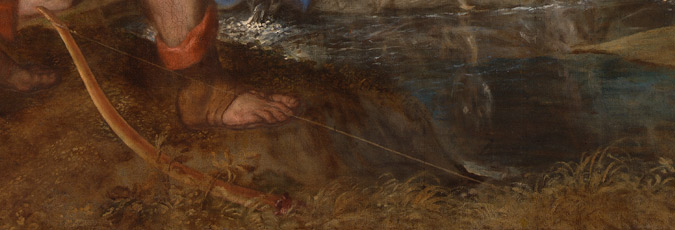Ben Haggarty, International Storyteller, examines the themes in 'Diana and Actaeon'.
In Titian's Diana and Actaeon we have not only a painting, but a portal into a rich and complex story – the story of Actaeon from the Roman poet Ovid's 'Metamorphoses', which inspired Titian.
The painting and the story contain plenty of material to spark lively debate and provoke a creative response in personal health and social education (PHSE), religious education (RE), history, philosophy and the creative arts.
Some themes are abstract, some are concrete. All are adult and any discussion should be carefully facilitated.

Virginity, nakedness and chastity
In Roman mythology, the virgin huntress Diana's main role was as protector of the virginity of all who are sent to her or who come to her. How do we view virginity, chastity and modesty today?
The symbolism of the hunt
Consider the thrill of the chase – what is it that makes it thrilling? Is it the hunter's exhilaration at having tracked down and killed his or her prey? Is it the taming of the wild or unknown? How is this thrill experienced now – through shopping, collecting, dangerous sports, politics, drugs, crime or war?
The wild versus the city
Diana is a queen of the forests. What does the forest represent for us today? Consider that, for at least 35,000 years, we did not live in cities and were much closer to nature.
Birth pains/childbirth
Until modern times, sex carried with it a high risk of killing the mother in childbirth. Mothers prayed to Diana for protection, as she was the goddess of childbirth.
Refuge and sanctuary
In Greek mythology, the temples of Artemis (Diana's Greek name) are places of sanctuary and refuge for women. Artemis was often shown protecting women from rape and rescuing women who were in flight.
Even as a child, Artemis asked her father if she could be a 'watcher over streets and harbours'.

Slavery
In Greek and Roman times, escaped slaves could seek sanctuary at the temples of Artemis. And later, in the Renaissance, Titian was painting at a time when slavery was an accepted and, indeed, growing practice in many parts of Europe.
The first European slave market dedicated to selling Africans was opened in Portugal in 1444. And in 1452 and 1455, the Pope let it be known that Christians could use pagans as slaves. In 1501, the first African slaves were transported by the Spanish to Hispaniola, now the Dominican Republic and Haiti.
Transgression, revenge and punishment
The story evokes broad moral themes. Diana's punishment of Actaeon is violent and yet the goddess doesn't cause the violence herself. Is this fair?
If Actaeon did not intend to find the goddess bathing then is his punishment justifiable? Should his accident go unpunished?
Are morality and justice subjective or objective? Is it possible to find an absolute truth? Is true justice ever possible?

